Cutting pipes at an angle: advantages and disadvantages of different methods + example of the work
Pipes are a widely used building material. They are used in the installation of various systems.During the installation process, situations arise when pipes need to be joined at an angle. The technology for producing such work is not standard, but you need to know about it.
To create complex connection configurations, pipes must be cut at an angle. We will tell you how such operations are performed and what cutting methods exist.
The content of the article:
Techniques for cutting pipes at an angle
When considering work methods—cutting straight or at an angle—one should take into account the different materials of the products being processed. Thus, hoses made of polypropylene or thin copper are easier and easier to cut than thick-walled steel pipes.
Plastic products of small diameters are cut at the desired angle using special scissors. In this case, you can control the angle with a regular protractor. Cutting of polymer pipes is also done with a conventional hacksaw with a fine-toothed blade.

The most common installation need is cutting water, sewer and ventilation pipes at an angle of 45º.
Let's find out what devices can be used for cutting at different angles.
Paper pattern for pipe
To perform a relatively accurate cut, you can use a simple technique, where an ordinary sheet of paper acts as a kind of pattern. For example, A4 printer paper is well suited for creating patterns.
The sheet is first marked into a square using a ruler.The diagonal size of the square should be equal to the circumference of the pipe that needs to be cut. Excess parts of the sheet are cut off.
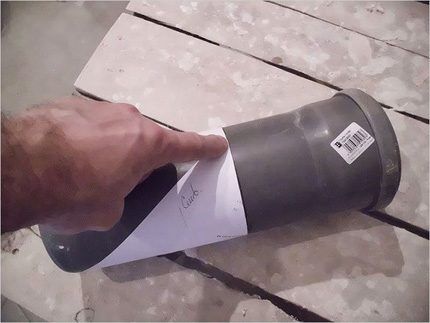
Next are the following steps:
- Bend the sheet diagonally, aligning opposite corners.
- Rotate the resulting triangle so that the hypotenuse line is perpendicular to the axis of the pipe.
- In this position, wrap the tube surface with paper, aligning the extreme points of the hypotenuse together.
- Use a marker to mark the cut along the line of any of the legs of the triangle.
- Cut the pipe along the marked line.
This method is quite convenient for marking and cutting pipes at an angle of 45º in the diameter range from 32 to 63 mm. For greater ease of marking, it is recommended to use thick but soft paper. You can also use paronite and similar materials.
How to choose wisely pipe cutter for plastic pipes and how to apply it in practice is described in detail in the article we propose.
Properly made patterns for shaped cutting of pipes allow you to make cuts with extremely high precision. In this case, a gap between the prepared workpieces is still possible. When connecting metal pipes, it is “closed” with a weld; when connecting plastic parts, a specialized soldering cord is used.
Programs for calculating cutting angles
Pattern cutting technology allows you to obtain different cutting angles. But to form a pattern at angles other than 45º, you will need to perform mathematical calculations and cut out a template from paper or similar materials based on the calculated data.
True, there are computer programs designed to save the master from making calculations. Patterns for cutting pipes are printed by such programs on a printer.
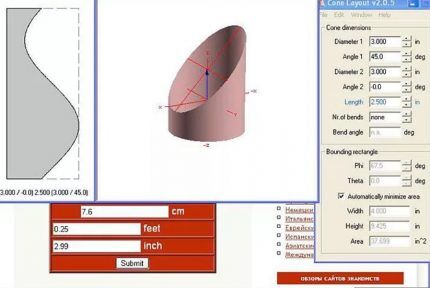
A simple calculation program created on the basis of the MS Excel application allows you to calculate and draw up a pattern for almost any pipe diameter and required cutting angle.
All the user needs to do is enter the appropriate values in the “Outer diameter” and “Cut angle” cells. Using these parameters, a pattern will be generated that can be sent for printing.
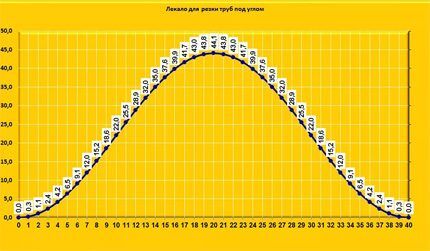
The disadvantage of the program is that it does not take into account the thickness of the pattern sheet, which leads to minor inaccuracies.
Miter box for cutting pipes
There is a simple tool that is often used in everyday life, mainly for working with wood. It's called a miter box. So, this same device is suitable for cutting pipes, and at different angles.
The miter box is commercially available, but if you wish, you can always make it yourself and adjust the structure to the desired pipe diameter:
- Take a wooden board with a width equal to the diameter of the pipe and a length of 400-500 mm.
- Take two more boards of the same dimensions, but increased in width by the thickness of the first board.
- From three boards, assemble a structure in the form of an inverted letter “P”, where the first board is installed as the base.
- In the central part of the structure, mark a rectangle, two sides of which run along the inner boundaries of the side boards.
- Divide the rectangle with diagonals and, along the lines obtained on the upper edges of the side boards, make cuts down to the base.
In this way, a template is made for cutting at an angle of 45º. But with the help of a protractor you can mark almost any angle and make cuts to cut the pipe for a specific angle.
The advantage of a miter box is that the tool is suitable for repeated use. Working with the tool is permissible until the walls of the slots are worn to such a degree that they can provide high cutting accuracy. It is recommended to make the walls of the instrument from a material of higher strength than wood.
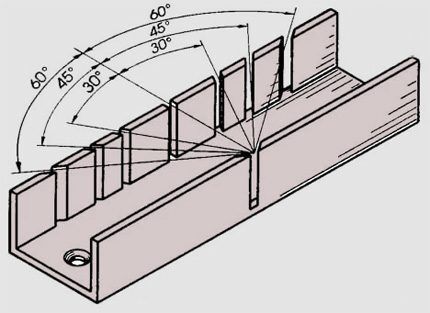
The advantages of the method are obvious - simplicity, ease of making a tool (miter box), efficiency, versatility. The disadvantages of working with this type of equipment are the need to adjust the dimensions of the miter box to the pipe diameter, provided that an accurate cut is performed. That is, for each pipe you will have to make your own tool.
Also, using a miter box, you can only cut a pipe with a hacksaw or pruning shears (for plastic products). This tool is not suitable for working with thick-walled metal pipes for cutting with a grinder.
Simple cutting equipment
Metal products of round and rectangular shapes with fairly thick walls can be conveniently cut at an angle using simple electromechanical equipment.
The cutting element of such a tool is a cutting disc or circular saw mounted on the electric motor shaft. In turn, the electric motor with the cutter is part of the entire equipment, which includes a work table, a pendulum support, and a clamp.

To install the pipe at the desired angle and then fasten it, a regular clamp and two metal corners are used. One corner (short) is attached to the base of the rotating mechanism - the pendulum. The second corner (long) is in a free state.
Pipe laying and cutting procedure:
- The rotating mechanism sets the required cutting angle (for example, using a ruler and a protractor).
- The found position is fixed with clamping screws.
- A pipe is placed between the short and long corners and pressed with a clamp screw.
- Voltage is supplied to the electric motor.
- By applying a slight pressure force to the cutter disk, the pipe is cut in the right place.
The advantages of this technique are fast work, accurate cutting, and the ability to process a large number of pipes in a short period of time.
Disadvantages: restrictions for use in domestic conditions, increased noise, work with pipes of only small and medium diameters. In addition, the cutting process with equipment is performed stationary at a distance from the installation site, which is not always acceptable.
If you are going to make copper piping at home, you will need special pipe cutters, we advise you to familiarize yourself with the selection rules.
The nuances of working with a rectangular section
To cut rectangular products, it is recommended to prepare template corner cuts in advance. They can be easily made from a metal corner, having previously been marked with the same protractor.
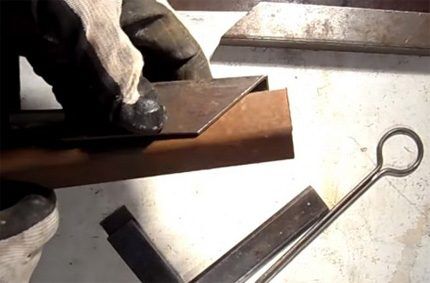
Marking can be done at different angles. To use a template, just attach it to the rectangular pipe in the right place and mark the cutting line. Then use any suitable tool to make a cut along the intended line.
Precision cutting devices
Among branded devices that could be used in everyday life to make cuts at an angle, you can pay attention to Italian-made equipment.
The Mini Cut band saw from the MASS company is a small-sized device with manual clamping, for working not only with pipes, but also with angles, rods, and profile elements.
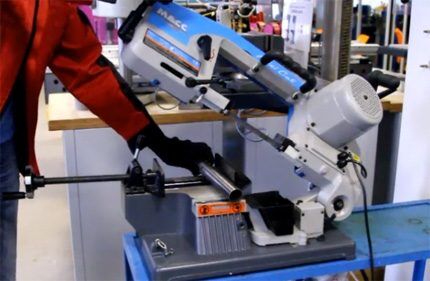
The machine supports setting the cutting angle from 0 to 45º. The procedure is carried out using a tape at a speed of 45 reciprocating movements per minute. The device is equipped with a 370 W electric motor, which is powered from a household network. The maximum permissible diameter of a round pipe to be cut is 65 mm.
On an industrial scale, numerous installations with electromechanical and electrical drives have been developed for pipe cutting. Technically sophisticated devices allow high-precision thermal, oxygen and plasma cutting:
Industrial models (using the example of BSM)
There are special machines for industrial use to perform precise miter cutting operations. A good example: devices produced under the BSM brand. The machine manufacturer is the German company Rexinger.
True, the BSM series machines are designed exclusively for working with polypropylene pipes of fairly large diameters. Processing of products such as PP, PVC, PE, PVDF is supported.

The cutting tool of the machine is a band saw, thanks to which cuts are made at angles from 0 to 67.5º. The accuracy of the process is ensured by a laser cutting recognizer.
Despite the configuration of the device for large-diameter products, you can use a special table, which can also be used to successfully cut small-diameter pipes (50 - 200 mm), which are easier to cut with using a pipe cutter. A wide range of BSM devices is produced.
Application of thermal methods
In addition to mechanical methods, thermal methods are often used, where welding or cutting machines are used as tools. For example, an autogenous gas cutter or a conventional welding machine (DC/AC).
With the help of such machines, thick-walled metal pipes can be cut. However, it is extremely difficult to obtain a perfectly even, high-quality cut using electric welding or gas autogen.
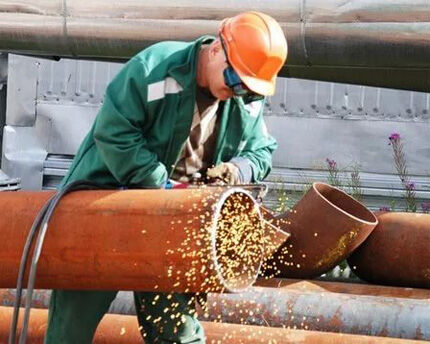
Cutting technology using electric welding and autogen is widespread everywhere. The technique does not provide high cutting accuracy, but when installing pipes this factor is often not decisive
Typically, after thermal cutting, products undergo additional processing. The cut line is aligned and the required angle values are adjusted. This approach is economically unprofitable, as it is accompanied by additional costs for mechanical processing.
As a rule, thermal cutting techniques are used in industrial production conditions. True, housing and communal services also often resort to this technique.
Thermal cutting is also used to work with plastic materials. There are devices - thermal guillotines. The sharp thin blade of such devices is heated to a high temperature, after which the cut is performed.
Thermal guillotines support cutting at an angle, and this is their advantage. However, these devices cannot be used to work with materials that are more rigid than polyvinyl chloride, wood, or chipboards.
For cutting metal-plastic pipes need pipe cutters, capable of evenly dividing into parts products with a multilayer structure. Our recommended article is devoted to their varieties and methods of application.
Conclusions and useful video on the topic
The video presents calculations and shows a workshop on cutting pipes at angles of 45º and 90º:
For each individual installation case, you can choose the most convenient and less expensive cutting method. The specific choice depends on the pipe material, its diameter, and wall thickness.
Using simple marking methods, you can get a fairly accurate angle at which you want to cut the workpiece. At the same time, using a complex calculation technique, it is possible to cut at non-standard angles with high accuracy.
Do you have useful information on the topic of the article? Did you have any questions while reading the material or discovered controversial issues? Please write comments in the block below.




There is no good way anywhere, all kinds of rubbish are everywhere! Well, what does a folded sheet of paper look like, attached to a pipe... a madhouse! I tried, using cardboard and a 45 degree square, to get the PERFECT oval line... Everyone thinks what they think... the result is manure!
Just look at numerous videos on YouTube, people can do everything. Perhaps the problem is not in the method, but in the execution? In addition, you need to understand that it will be difficult to achieve the ideal result manually. Even in industry there is a tolerance of up to 0.5 degrees
paper, of course, is not a fountain.
you need to make a hoop of the required size from a metal rod, at least 5 mm, so that it is rigid, compress it into an ellipse...
or take a plumbing “clamp” to tighten the hose on a brush (made of a metal tape with slots and a screw) of the required size
Give me a link to download the program for calculating cutting angles